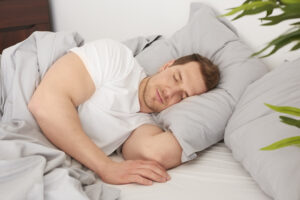
Sleep Apnea and High Blood Pressure: Understanding the Connection
Sleep apnea is a complex issue that affects multiple intricate systems in our bodies, including the respiratory, cardiovascular, and nervous systems. It is often misconceived

A comprehensive guide to comprehending the various categories of CPAP masks
Choosing the right CPAP mask can be a daunting task, especially if you’re new to purchasing one, due to the wide variety of options available for individuals diagnosed with obstructive sleep apnea (OSA).
Ensuring that you find a CPAP mask that suits your specific requirements, preferred sleeping position, and lifestyle is crucial in ensuring adherence to CPAP therapy. According to a study published in The Clinical Respiratory Journal in 2016, individuals who used a well-fitting mask reported fewer instances of leakage and discomfort, and were also able to tolerate higher therapy pressures.
Based on these discoveries, we have developed this comprehensive guide to assist you in navigating through the various types of CPAP masks, ensuring that you can find the most suitable option for your lifestyle and therapy requirements. Once you and your doctor have determined the ideal mask type for you, we highly recommend referring to our latest guide on the best CPAP masks. In this guide, we compare leading brands based on factors such as mask type, comfort, lifestyle compatibility, and more.
To begin, let’s establish some fundamental aspects before delving into an in-depth analysis of the various CPAP mask types. Additionally, we will address common challenges that may arise during therapy and provide effective solutions for overcoming them.
What Is a CPAP Mask?
A CPAP mask serves as the means through which pressurized air is delivered to the airway of individuals undergoing CPAP therapy. This mask is connected to the CPAP machine through a hose or tubing and is available in diverse styles, sizes, and materials.
There are different variations of CPAP masks available, including the traditional design that covers the wearer’s nose with a triangular cushion. However, there are also masks that rest under the nose, masks that cover both the nose and mouth, masks designed specifically for the mouth, and even masks that cover the entire face.
The primary function of the mask is to establish an airtight seal, ensuring that the air pressure remains consistent as it passes through the airway. It is essential to find a mask that accomplishes this task without being overly tight, causing facial sores, or necessitating frequent readjustment.
Anatomy of a Typical Mask
The majority of CPAP masks consist of three primary components:
It is important to consider the materials used in the mask, as they will come into contact with and rub against your face during sleep. If you experience any skin discomfort, we offer solutions such as fabric wraps and cloth mask liners to enhance comfort levels and alleviate irritation.
Common Types of CPAP Masks Prescribed
Among the seven available types of CPAP masks, doctors commonly prescribe three specific types for sleep apnea patients using a CPAP machine:
Now, let’s delve into a detailed discussion of each of these three mask types:
1. Full Face Mask
Full Face CPAP masks create a seal around both the nose and mouth, utilizing triangular-shaped cushions, and are secured in place by four-point headgear.
These masks are particularly suitable for individuals who breathe through their mouth and prefer not to use a nasal mask along with a chinstrap.
However, it’s worth noting that full face masks tend to be heavier and bulkier due to their coverage of both the nose and mouth. Notably, CPAP equipment manufacturers such as ResMed and Philips Respironics have introduced full face masks that offer a significantly improved field of vision.
Several common reasons why a full face mask may be necessary include:
If you try a full face mask and find that it is too bulky or doesn’t work for you, try switching to a nasal or nasal pillow mask.
2. Nasal Masks
A nasal CPAP mask is positioned on the bridge of the nose and typically covers either the entire nose or the lower half. The mask is secured in place by four-point headgear that attaches to the frame. It’s worth noting that irritation may occur on the bridge of the nose where the mask rests.
Nasal masks are widely favored due to their minimalist design. However, for some individuals, inadvertent mouth breathing can lead to issues such as CPAP dry mouth and dry throat. This concern can be addressed by using a chin strap to keep the mouth closed during sleep. Alternatively, some people opt for a full face mask. It is important to mention that a nasal mask is not recommended for individuals experiencing chronic nasal congestion, severe allergies, or those with conditions like a deviated septum or nasal obstruction, as it may pose challenges in such cases.
3. Nasal Pillow Mask
Nasal pillow CPAP masks establish a seal at the base of the nostrils where the cushion is positioned. This style of mask is the least intrusive and offers a clear field of vision, making it suitable for activities such as reading or watching TV. It is particularly beneficial for men with facial hair. Nasal pillow masks are often favored for their comfortable fit and minimalist design, contributing to higher compliance rates among users.
Nevertheless, there are situations where a nasal pillow mask may not be the optimal choice. For instance, if your prescribed pressure setting is higher or if you experience nasal allergies or chronic nasal obstruction, this mask type may not be the most suitable for you.
Occasionally, irritation may occur at the nostril opening, both internally and externally. If you encounter discomfort of this nature, you can try using a nasal pillow of a different size or consider using a nasal moisturizer to aid in adjustment.
Common CPAP Mask Problems and How To Solve Them
Red Marks: If you notice red marks on your face, it is likely due to the mask being too tight. Try loosening the straps and check if you still achieve a proper seal. If not, consider exploring alternative masks or different styles that may provide a better fit.
Mask Leaks: Mask leaks can be a frustrating issue for CPAP users. After all, if the mask doesn’t seal properly, it cannot effectively perform its function. One potential solution is to use mask liners, which offer cloth padding between the mask and your face. These liners can enhance comfort and improve the seal compared to not using one. Additionally, mask liners can help prolong the lifespan of silicone masks, as perspiration and facial oils can gradually degrade the silicone material over time.
Dry Nose and Mouth: If you experience dryness in your nose or mouth during therapy, there is a simple remedy available. Incorporating a CPAP humidifier can introduce moisture into the air delivered during your therapy, reducing dryness. This not only enhances comfort but also indirectly promotes compliance by making the experience more pleasant.
This blog post contains general information about medical conditions and potential treatments. It is not medical advice. If you have any medical questions, please consult your doctor.

Sleep apnea is a complex issue that affects multiple intricate systems in our bodies, including the respiratory, cardiovascular, and nervous systems. It is often misconceived

When we think about leading a healthy lifestyle, we often consider healthy eating and regular exercise. However, we must also prioritize rest and recovery, and

Obesity is a pressing issue not only for adults, but also for children and adults worldwide. In Australia, approximately 67% of adults are considered overweight

Delivery with in 3-5
working days

Return Your Order

We accept all major
credit cards

Customer service and
support